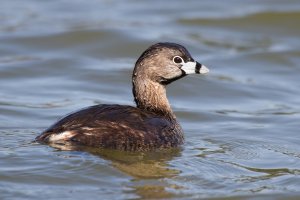Bird of the Week: Pied-billed Grebe
 If you’ve ever seen a small, dark shape disappear underwater in one of Michigan’s many water bodies and thought your eyes were playing tricks on you, check again. It might just be this amazing diver. Pied-billed Grebes can stay underwater for long periods of time and can travel surprisingly far while submerged, so they may pop back up in a completely different location. If they feel threatened, they might not even resurface fully, but instead stick just the top of their head and nostrils above the water’s surface to scope things out. Although they might look and act a bit like ducks, grebes are not all that closely related to them. They have a much different bill shape and instead of the webbed feet we’re used to seeing on ducks, they have lobed toes to help them swim. One thing the two bird groups do share is that their young are ready to swim remarkably soon after hatching, although baby grebes tend to take a lot of free rides on a parent’s back during the first week out of the nest. Pied-billed Grebes eat a variety of smaller animals, but primarily crustaceans and small fish, and strangely, a lot of their own feathers. This is thought to be done to help protect the lining of their stomach and intestines from the hard, sharp pieces of their favorite prey. It also aids in the formation of pellets that are then regurgitated to remove those undigestible items. Pied-billed Grebes are relatively common in Michigan, and though secretive in summer, will nest even in areas with a moderate amount of human activity. Keep a close eye out on the water for this bird next time you’re near a lake or pond, including at your local Metroparks!
If you’ve ever seen a small, dark shape disappear underwater in one of Michigan’s many water bodies and thought your eyes were playing tricks on you, check again. It might just be this amazing diver. Pied-billed Grebes can stay underwater for long periods of time and can travel surprisingly far while submerged, so they may pop back up in a completely different location. If they feel threatened, they might not even resurface fully, but instead stick just the top of their head and nostrils above the water’s surface to scope things out. Although they might look and act a bit like ducks, grebes are not all that closely related to them. They have a much different bill shape and instead of the webbed feet we’re used to seeing on ducks, they have lobed toes to help them swim. One thing the two bird groups do share is that their young are ready to swim remarkably soon after hatching, although baby grebes tend to take a lot of free rides on a parent’s back during the first week out of the nest. Pied-billed Grebes eat a variety of smaller animals, but primarily crustaceans and small fish, and strangely, a lot of their own feathers. This is thought to be done to help protect the lining of their stomach and intestines from the hard, sharp pieces of their favorite prey. It also aids in the formation of pellets that are then regurgitated to remove those undigestible items. Pied-billed Grebes are relatively common in Michigan, and though secretive in summer, will nest even in areas with a moderate amount of human activity. Keep a close eye out on the water for this bird next time you’re near a lake or pond, including at your local Metroparks!
